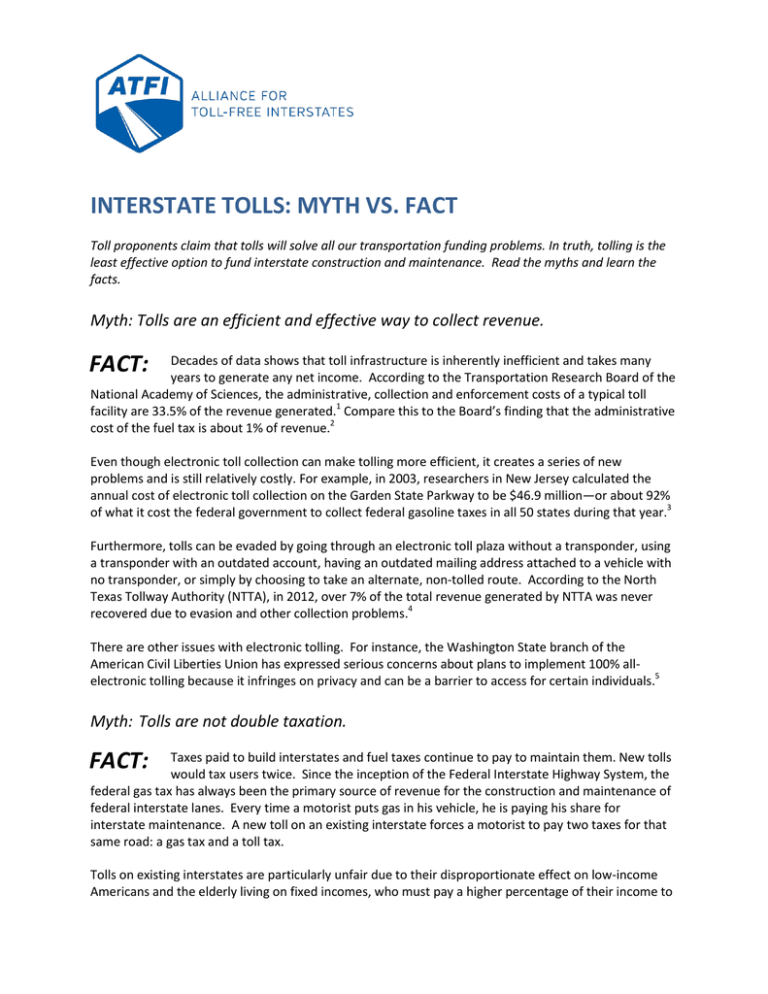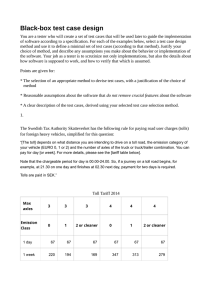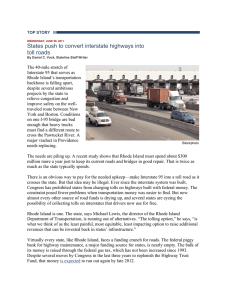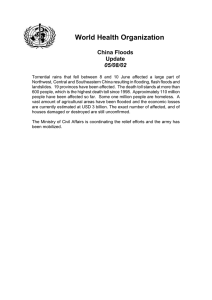INTERSTATE TOLLS: MYTH VS. FACT FACT: FACT:
advertisement

INTERSTATE TOLLS: MYTH VS. FACT Toll proponents claim that tolls will solve all our transportation funding problems. In truth, tolling is the least effective option to fund interstate construction and maintenance. Read the myths and learn the facts. Myth: Tolls are an efficient and effective way to collect revenue. FACT: Decades of data shows that toll infrastructure is inherently inefficient and takes many years to generate any net income. According to the Transportation Research Board of the National Academy of Sciences, the administrative, collection and enforcement costs of a typical toll facility are 33.5% of the revenue generated.1 Compare this to the Board’s finding that the administrative cost of the fuel tax is about 1% of revenue.2 Even though electronic toll collection can make tolling more efficient, it creates a series of new problems and is still relatively costly. For example, in 2003, researchers in New Jersey calculated the annual cost of electronic toll collection on the Garden State Parkway to be $46.9 million—or about 92% of what it cost the federal government to collect federal gasoline taxes in all 50 states during that year.3 Furthermore, tolls can be evaded by going through an electronic toll plaza without a transponder, using a transponder with an outdated account, having an outdated mailing address attached to a vehicle with no transponder, or simply by choosing to take an alternate, non-tolled route. According to the North Texas Tollway Authority (NTTA), in 2012, over 7% of the total revenue generated by NTTA was never recovered due to evasion and other collection problems.4 There are other issues with electronic tolling. For instance, the Washington State branch of the American Civil Liberties Union has expressed serious concerns about plans to implement 100% allelectronic tolling because it infringes on privacy and can be a barrier to access for certain individuals.5 Myth: Tolls are not double taxation. FACT: Taxes paid to build interstates and fuel taxes continue to pay to maintain them. New tolls would tax users twice. Since the inception of the Federal Interstate Highway System, the federal gas tax has always been the primary source of revenue for the construction and maintenance of federal interstate lanes. Every time a motorist puts gas in his vehicle, he is paying his share for interstate maintenance. A new toll on an existing interstate forces a motorist to pay two taxes for that same road: a gas tax and a toll tax. Tolls on existing interstates are particularly unfair due to their disproportionate effect on low-income Americans and the elderly living on fixed incomes, who must pay a higher percentage of their income to be able to access the interstate.6 Within a city or a town there may be a number of alternate route choices, but there is no economically viable substitute for the Interstate Highway System in terms of connecting people and goods over long distances. Myth: Tolls should replace fuel taxes as a means to collect transportation revenue. FACT: Unlike tolls, the fuel tax is a fair and efficient way to collect revenues for road use. It is not realistic to place tolls on every mile of existing roads, whereas the fuel tax is an accurate gauge of road use. Certain new infrastructure projects that expand road capacity could be appropriate candidates for toll financing. However placing tolls on existing interstate lanes is the most inefficient method to fund the maintenance of current capacity and the construction of new capacity. While it is true that today’s fuel tax revenues are not keeping pace with our highway transportation needs and creative solutions must be explored, tolls are by far the worst way to solve our transportation funding deficit. A typical toll facility expends 33.5% of revenue generated on administrative, collection and enforcement costs.7 While electronic toll collection can make tolling more efficient, it still requires expensive infrastructure, creates privacy concerns, causes traffic diversion, hurts commuters, and is bad for businesses. Myth: Electronic tolls eliminate safety and congestion concerns. FACT: Electronic tolls can cause delays and make roadways less safe by disrupting traffic patterns around the toll facility. Traffic diversion creates congestion on the local and secondary roads near toll facilities. This congestion delays response times for emergency personnel who rely on these secondary routes to quickly get to and from accidents and emergencies. A recent study on the effects of tolls in North Carolina predicted that tolls would divert up to 36% of traffic to alternate routes, contributing to delays, traffic accidents, and wear and tear on smaller secondary roads that were not built to handle high traffic levels.8 Myth: Electronic toll collection users should feel safe that their data is only used for toll-collection purposes. FACT: Electronic toll collection devices, such as E-Z Pass®, employ small RFID (radio-frequency identification) transponders to identify and automatically collect toll payments from registered users as they pass through toll facilities. There is no uniform national policy in place holding toll operators to specific standards for handling amassed personal information.9 A 2007 investigation found that in 7 out of the 12 states that employed the E-Z Pass® electronic tolling system at the time, data collected through the system was released for use in criminal and civil court cases, including divorce proceedings, and in 4 other states data was released for criminal cases.10 Participants in electronic toll collection programs should be aware that the RFID transponders in their devices enable them to be tracked outside tolling facilities and that their personal information can be used by groups and agencies other than toll operators. For instance, New York City tracks cars using E-Z Pass®, supposedly to collect data on traffic patterns.11 Any solution to transportation funding that would require all-electronic toll collection would represent a serious infringement on driver privacy. The Washington State ACLU has raised serious concerns about drivers being forced to surrender their personal information to private companies or government entities simply to drive on the Interstate Highway System.12 Myth: The interstates are not paid for. FACT: Every day, drivers pay for the construction and maintenance of the federal interstate system when they purchase gas. The federal gas tax is the primary mechanism for funding the interstate system. Revenue generated from the gas tax funds ongoing construction and maintenance of the interstate system throughout the country. Some states, like Virginia, require that road maintenance take priority over construction. The Code of Virginia mandates that transportation revenue first be distributed into the maintenance fund before money is allocated to construction projects. This includes the maintenance of the federal interstates located in Virginia.13 Gas tax collections are often more than sufficient to cover road maintenance costs. For example, in 2007, Pennsylvania trucks and cars paid an estimated $130 million in fuel taxes and user fees for the miles driven on Interstate 80 (I-80), while maintenance and operation of I-80 cost the Pennsylvania Department of Transportation an average of $80 million per year at that time.14 Existing interstate lanes have been and will continue to be paid for as long as the federal gas tax is collected. Allowing new tolls on existing interstate lanes would be a violation of the public trust because gas tax-dedicated revenue has been the mechanism for funding interstate maintenance and construction since the Interstate Highway System was established in 1956. Myth: Local citizens won't be hurt by interstate tolls since primary toll payers are out-of-state drivers. FACT: Local citizens may have to pay tolls every time they use the interstate to commute to work, drive to the grocery store, or drop their kids off at school. In addition, tolls increase the cost of delivering goods and services, putting local businesses at a competitive disadvantage and increasing the cost of living for residents. A 2009 study on the impact of potential tolls on I-80 in Pennsylvania estimated that shippers, truckers, and consumers would suffer a combined annual deadweight loss of between $8 and $15 million dollars per year.15 In Mercer Island, Washington, where officials are considering adding tolls to I-90, it is estimated that workers commuting to the island will pay an extra $1,300 each year just to get to and from work.16 Beyond the direct effects of paying the toll, local communities must deal with the consequences of traffic diversion created by tolls. Local roads deteriorate when they must accommodate traffic volumes that they were not built to handle. When these roads need to be fixed, it is the local communities and states that must pay. This diversion also hurts local businesses that depend on interstate drivers for their customers. A 2013 Economic Assessment of I-95 in North Carolina estimated that between 2014 and 2050 diversion from tolls on I-95 would cost approximately $1.1 billion dollars in revenue to businesses within a mile of the I-95 corridor in North Carolina.17 1 Transportation Research Board, National Cooperative Highway Research Program, 2011. Cost of Alternative Revenue-Generating Systems: p7274. 2 Transportation Research Board, National Cooperative Highway Research Program, 2011. Cost of Alternative Revenue-Generating Systems: p62. 3 Jonathan R. Peters and Jonathan K. Kramer, 2003. “The Inefficiency of Toll Collection as Means of Taxation: Evidence from the Garden State Parkway,” Transportation Quarterly 57.3: p20. Accessed October 30, 2013 http://www.cunyspsc.org/files/papers_o/p_TRA_2003_06_PetersKramer%20TQ%20Sum%202003_o.pdf 4 Brandon Formby, “Some holes in North Texas toll collecting hard to close,” Dallas News. October 20, 2013. Accessed October 30, 2013 http://www.dallasnews.com/news/transportation/20131020-some-holes-in-north-texas-toll-collecting-hard-to-close.ece?nclick_check=1 5 ACLU of Washington, 2009. Tolling Position Paper. Accessed October 30, 2013 http://www.aclu-wa.org/library_files/TollingPositionPaper.pdf 6 Jonathan R. Peters and Jonathan K. Kramer, 2003. “The Inefficiency of Toll Collection as Means of Taxation: Evidence from the Garden State Parkway,” Transportation Quarterly 57.3: p26. Accessed October 30, 2013 http://www.cunyspsc.org/files/papers_o/p_TRA_2003_06_PetersKramer%20TQ%20Sum%202003_o.pdf 7 Transportation Research Board, National Cooperative Highway Research Program, 2011. Cost of Alternative Revenue-Generating Systems: p72-74. 8 Cambridge Systematics, Inc. for North Carolina Department of Transportation, 2013. North Carolina I-95 Economic Assessment: p3.26. Accessed November 4, 2013 http://www.driving95.com/assets/pdfs/_North_Carolina_I-95_Economic_Assessment.pdf 9 “State Statutes Relating to Radio Frequency Identification (RFID) and Privacy,” National Conference of State Legislatures. Accessed November 7, 2013 http://www.ncsl.org/research/telecommunications-and-information-technology/radio-frequency-identification-rfid-privacy-laws.aspx 10 Chris Newmarker, “Toll Records Catch Unfaithful Spouses,” Associated Press. Accessed October 30, 2013 http://abcnews.go.com/Technology/story?id=3468712&page=1 11 Kashmir Hill, “E-ZPasses Get Read All Over (Not Just at Toll Booths),” Forbes. September 12, 2013. Accessed October 30, 2013 http://www.forbes.com/sites/kashmirhill/2013/09/12/e-zpasses-get-read-all-over-new-york-not-just-at-toll-booths/ 12 ACLU of Washington, 2009. Tolling Position Paper. Accessed October 30, 2013 http://www.aclu-wa.org/library_files/TollingPositionPaper.pdf 13 Allocation of funds among highway systems. Virginia Code, § 33.1-23.1 14 Miller, Tracy C. 2009. I-80 Tolling Impact Study: p3-4. Accessed November 7, 2013 http://www.thenewspaper.com/rlc/docs/2009/pagcctoll.pdf. 15 Miller, Tracy C. 2009. I-80 Tolling Impact Study: p7. Accessed November 7, 2013 http://www.thenewspaper.com/rlc/docs/2009/pagcctoll.pdf. 16 “Mercer Island School District says that tolling will cost $500,000,” Mercer Island Reporter. October 10, 2013. Accessed October 30, 2013 http://www.mi-reporter.com/news/227266021.html 17 Cambridge Systematics, Inc. for North Carolina Department of Transportation, 2013. North Carolina I-95 Economic Assessment: p3.47. Accessed November 4, 2013 http://www.driving95.com/assets/pdfs/_North_Carolina_I-95_Economic_Assessment.pdf


